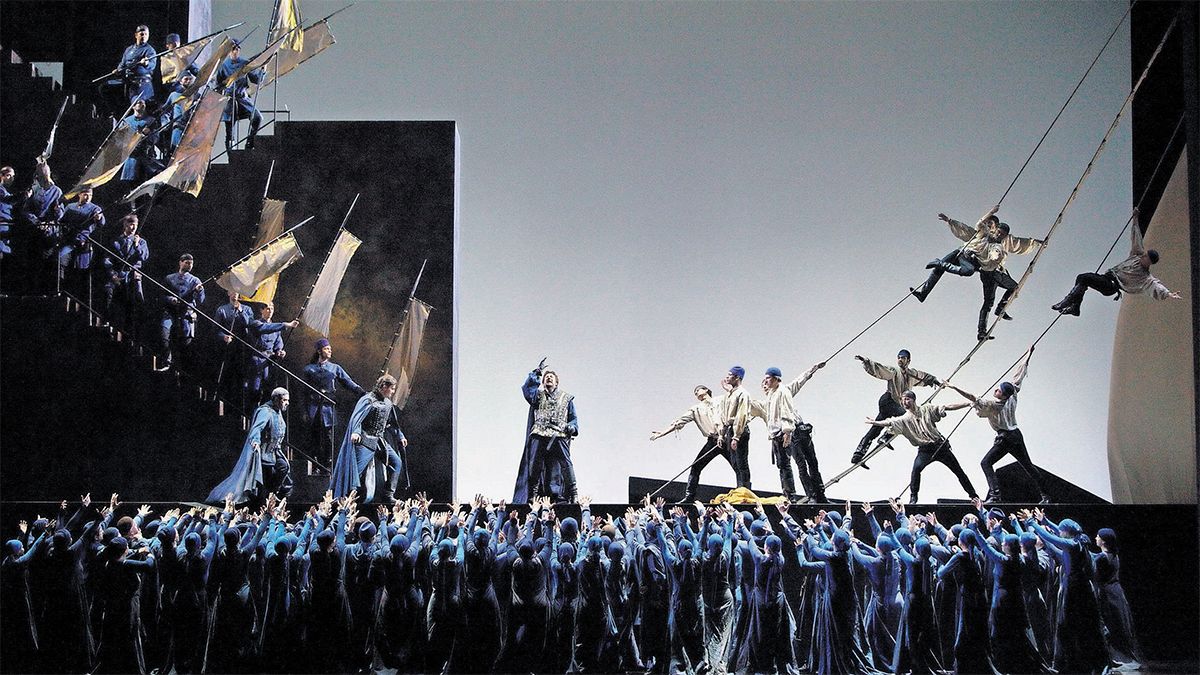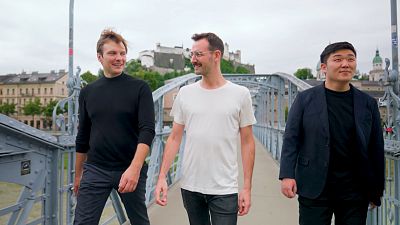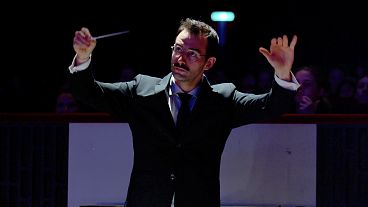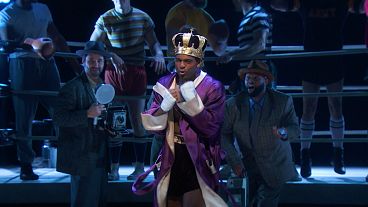Article brought to you by
2013-14
A SEASON OF THOUGHTFUL DELIGHTS
When the curtain rises at Teatro alla Scala on Dec. 7, the opening night audience will feel reassured. They will see an elegant Parisian salon, what one would expect in a traditional production of one of Verdi’s most beloved operas, ‘‘La Traviata.’’
But there are surprises in store. This brand-new production will be not quite what the audience expects, and that is exactly as Stéphane Lissner, general manager of La Scala, would have it. ‘‘My idea of a public theater is not to see and be seen in nice clothes and sip Champagne between acts, but to make people think,’’ he says. ‘‘Our mission should not be primarily to charm and delight an audience but to make the public reflect and think. Thinking can also be delightful, no?’’
One assuredly delightful aspect of the production will be the singing. Diana Damrau has the role of Violetta, and Lissner calls the German soprano the definitive Violetta of our time. He booked her for the part four years ago, before he had a director or conductor. Alfredo is played by Polish-born Piotr Beczala, and Zeljko Lucic, a Serbian baritone, sings the role of Giorgio.

The Russian director Dmitri Tcherniakov’s new production of ‘‘La Traviata’’ opens the season.
© Brescia-Amisano / Teatro alla Scala
The link to Verdi’s Italian heritage is assured by the conductor, Daniele Gatti, who is from Milan. The psychology that drives the production comes from its Russian director, Dmitri Tcherniakov. He is young (43), serious, daring and introspective. Having begun his career as an orchestral violinist, he has a special understanding of opera music. According to Lissner, Tcherniakov is ‘‘one of the three greatest directors working in the theater today.’’
The Russian will have another opportunity to stimulate the Scala’s audiences in the coming season. He worked with Daniel Barenboim, the house’s musical director, on ‘‘The Czar’s Bride,’’ an opera by Rimsky-Korsakov rarely seen outside of Russia. The strikingly modern co-production with the Berlin Staatsoper (where Barenboim also serves as musical director), with the secret police in business suits and the use of projected graphics, was highly appreciated by the audience at its debut in Berlin. It opens at La Scala in March 2014.

Rolando Villazón made his Scala debut as Nemorino in ‘‘L’Elisir d’Amore’’ in 2010.
© Brescia-Amisano / Teatro alla Scala
Barenboim will conduct two other operas in the coming season, his last at La Scala. One is a new production of Mozart’s ‘‘Così fan Tutte,’’ considered a classic of Italian opera. Rolando Villazón will play Ferrando in the production.
Rossini’s ‘‘Le Comte Ory’’ is another opera that is not often seen. A new coproduction with the Opéra National de Lyon, directed by Laurent Pelly with Juan Diego Flórez in the title role, it will debut in July.
An unusual, mixed program is on the schedule for January and February, with two ballets—‘‘Le Spectre de la Rose’’ with choreography by Michail Fokin and ‘‘La Rose Malade’’ by Roland Petit — and a one-act opera, ‘‘Cavalleria Rusticana,’’ conducted by Daniel Harding.
French opera will take the spotlight in April with a major production of grand opera and a masterpiece of the French repertory, ‘‘Les Troyens,’’ by Berlioz. In the golfo mistico, the pit, will be Anthony Pappano, one of the leading conductors of our time and the music director of the Royal Opera in London. English-born of Italian parents, he has conducted concerts at La Scala, but never an opera.
Expectations are high for another massive show (a co-production with six different opera houses involved): Richard Strauss’s ‘‘Elektra.’’ It is important in part because 2014 marks the 150th birthday of Strauss.
There is a second, more contemporary reason: ‘‘Elektra’’ debuted at Aix-en-Provence this past summer under the direction of Patrice Chéreau, who died in October at the age of 68. The French theatrical and film director, an Oscar winner in the latter category, is consistently named among the top directors of theater and opera worldwide. Chéreau has often worked to acclaim with Lissner and Barenboim, notably for the 1992 ‘‘Wozzeck’’ by Alban Berg at the Staatsoper, Mozart’s ‘‘Don Giovanni’’ at the Salzburg Festival in 1994 and the ‘‘Tristan und Isolde’’ by Richard Wagner that opened at the Scala in 2007.
Other offerings are the always-popular ‘‘Lucia di Lamermoor,’’ a co-production with the Metropolitan Opera of New York, and ‘‘Il Trovatore,’’ both opening in February.
The final opera of the 2013-14 season is another Verdian staple, ‘‘Simon Boccanegra.’’ For five of its nine performances, it will be conducted by Barenboim and star Plácido Domingo in the title role.
The first opera of the 2014-15 season will be Barenboim’s swan song at La Scala. ‘‘Fidelio,’’ Beethoven’s only opera, will be directed by Deborah Warner, an Englishwoman who has already enjoyed great success with Milanese audiences with a sensitive 2011 production of Britten’s ‘‘Death in Venice.’’
LEADERSHIP
NEW DIRECTION FOR YEARS AHEAD
Change is inevitable, even to as venerable an institution as Teatro alla Scala. Over its 235-year history, La Scala has restructured its interiors, expanded its property holdings, created a school for the performing arts and started a museum. This year, the ballet school celebrates its 200th birthday and the museum marks 100 years of operation.
Next year will bring more change than usual. The current managing director of La Scala, Stéphane Lissner, will leave Milan to head the Paris Opera on Sept. 1, 2014. The musical director, Daniel Barenboim, will resign at the end of 2014, after having conducted the opening opera of La Scala’s 2014-15 season.

Plácido Domingo will perform the title role of Verdi’s ‘‘Simon Boccanegra,’’ conducted by Daniel Barenboim, La Scala’s musical director.
© Brescia-Amisano / Teatro alla Scala
Because opera programming happens years in advance, the new managing director has been named. He is Alexander Pereira, born in Vienna but no stranger to Italy: he worked for Olivetti for 12 years. Pereira began his professional music management career in 1984 and worked for 20 years as director of the Zurich Opera House. He will come to Milan from Salzburg, where he was most recently director of the Salzburg Festival.
Lissner will leave Pereira with 80 percent of the following season’s schedule already completed. ‘‘My successor will add and adjust to it but the basic program is done,’’ says Lissner.
The 2014-15 season is exceptional because the 2015 World’s Fair will be held in the city and La Scala will be open in August. Because the fair’s theme is ‘‘feed the planet, energy for life,’’ Lissner commissioned the composer Giorgio Battistelli to create a new opera around the themes of food and ecology, based upon ‘‘An Inconvenient Truth,’’ the movie about climate change by Al Gore, the former U.S. vice president. It will debut in May 2015, with Robert Carsen as the director and Gianandrea Noseda conducting.
Reflecting on his time in Milan, Lissner recalls an interview he gave when he first came to La Scala in 2005. ‘‘I said that if I were lucky, I would stay at most 10 years,’’ he says. ‘‘That is the maximum, I think, that someone should be in this position. I will have worked here nine years by the time I leave, so the timing is perfect.’’
Emphasizing that he will continue to work with La Scala in co-productions, he adds: ‘‘This has been one of the great adventures of my life, truly fantastic. You must come to work each day with passion for what you are doing.’’
RECITALS
SINGING, PURE AND SIMPLE
Opera enthusiasts can’t get enough of their favorite singers. Recitals help meet the demand for appearances by beloved artists. The singer provides the entire show, with a program and a piano accompanist chosen by him or her. Thus a recital ensures an artistic freedom to the performer that an opera appearance cannot provide.
Recitals by opera stars began in the early 20th century. Before then, recitals consisted of a pianist alone (as championed by Franz Liszt) or hybrid programs including both singers and musicians—usually a violinist and a pianist.
La Scala has been presenting singing recitals for half a century, and will offer seven of them in the coming season.

Jonas Kaufmann, who starred ‘‘Lohengrin’’ at La Scala last year, will sing a recital there in April 2014.
© Brescia-Amisano / Teatro alla Scala
All seven artists have sung at La Scala before, so they are no strangers to the opera house and the tastes of its demanding audience. On March 3, 2014, Ferruccio Furlanetto will appear. The Italian bass has a strong international following and played the title role in La Scala’s ‘‘Don Carlo’’ in 2008.
Furlanetto will be followed on April 14 by the German tenor Jonas Kaufmann, one of today’s most dazzling opera stars, in an appearance supported by Rolex. Kaufmann was the star of La Scala’s ‘‘Carmen’’ in 2009 and headlined last year’s season opener, ‘‘Lohengrin.’’
May 25 will mark a recital by the Mexican tenor Roland Villazón, who has sung infrequently at La Scala. He will be accompanied by La Scala’s musical director, Daniel Barenboim, at the piano, so the program is practically a doubleheader.
Anja Harteros, the German considered one of opera’s top sopranos, follows on June 22. In November 2014, she will sing the role of Amelia in ‘‘Simon Boccanegra,’’ a reprisal of her 2010 performance.
Another soprano, the Italian Maria Agresta, will be the recital headliner on Sept. 8. Her expressive voice has been shown to advantage in many Verdi works, including ‘‘Il Trovatore,’’ ‘‘Nabucco’’ and ‘‘Oberto, Conte di San Bonifacio,’’ the latter at La Scala.
Bryn Terfel will take a turn on Sept. 28 in another appearance supported by Rolex. The Welsh bass baritone debuted at La Scala in ‘‘The Marriage of Figaro’’ in 1997 and has returned often, most recently earlier this year as a forceful and comedic Falstaff applauded by the critics.
The final recital of 2014 will be that of the German baritone Matthias Goerne. Goerne specializes in lieder, which was the original repertory of recital singers. His lieder program in April 2013 at La Scala delighted the audience.
MUSEUM
REPOSITORY OF A STORIED HISTORY
For music lovers in general—and opera fans in particular—a visit to La Scala is not complete without stopping at the Museo Teatrale alla Scala, the museum housed in a building adjacent to the theater. The museum is celebrating its 100th birthday at the same address, though there have been many changes since it first opened on March 8, 1913.
‘‘The original idea was to create a pinacoteca, a gallery where La Scala patrons could go to browse interesting objects during the intermissions of the opera,’’ explains Matteo Sartorio, curator for the museum and its affiliated Livia Simoni Library.
The idea had been discussed for a decade at the beginning of the 20th century when an auction in Paris became a catalyst for action. The estate of Giulio Sambon, a Neapolitan antiquarian, was to be sold in 1911. It consisted of many items related to theater, not just opera, and attracted the attention of the Milanese and also of J.P. Morgan, acting for the Metropolitan Museum of New York.
Intrigue worthy of an Italian opera ensued and, many maneuvers later, the collection was en route to Milan, paid for in part by contributions from private citizens of the city. ‘‘They were not just one or two wealthy patrons or La Scala itself, but the general citizenry. So we can say that this museum really belongs to the people of Milan,’’ emphasizes Sartorio.
The items arrived in 1911 but it took two years to catalog them, and the museum officially opened in 1913. At the time, it had 10,000 volumes of music criticism, biography and musical scores. The Livia Simoni Library became its own entity in 1952, when the Italian music critic Renato Simoni donated 54,000 books to La Scala in honor of his mother.

La Scala’s museum, housed in a building adjacent to the theater, is celebrating its 100th birthday.
© Brescia-Amisano / Teatro alla Scala
Both museum and library have grown substantially. Today they house more than 350 paintings and sculptures, 50 miniatures, over 150 porcelain figures, a collection of puppets, musical instruments and artisanal objects, and 150,000 books and related items. The latter include 10,300 letters from composers, directors and singers, 2,255 sketches of theater scenes, 3,000 posters, 6,000 libretti, 30 complete opera manuscripts and 7,000 photographs.
The curiosities include Puccini’s watch, Rossini’s glasses, locks of Mozart’s hair, a cast of Chopin’s hand and—among many items of Verdiana — his first spinet, his grand piano and 200 personal letters written by him.
The museum is in the process of digitizing everything. ‘‘Computers have changed things dramatically for us,’’ notes Sartorio. ‘‘We don’t display original letters, but rather digital copies. Letters, manuscripts, paintings, puppets and many other items are not physically here in the museum. They are stored safety elsewhere, and we make digital versions available.’’
Digitization came in very handy in 2013, the year of the Verdi bicentennial. The museum had a huge outpouring of requests for images of the composer, given his close affiliation with La Scala.
The introduction of new technology in the museum was facilitated by the restructuring of the opera house between 2001 and 2004. ‘‘Fifteen years ago, we had major structural problems,’’ admits Sartorio. So when La Scala closed for a three-year renovation, that also became an opportunity to modernize the museum. While the theater moved to Teatro Ansaldo, the museum and library were transferred to a separate site near the Church of the Last Supper.
The design of the restructured museum was the subject of vigorous discussion. Should it retain the ambience of the past or break with tradition and move into the future? Pier Luigi Pizzi, anoted set designer and director at La Scala, opted for a re-creation of the atmosphere of the museum as it was when it first opened.
Today the museum and library are under the direction of Renato Garavaglia, who has worked at La Scala since 1984. He oversees the permanent, temporary and traveling exhibits, a staff of 10 and an influx of 230,000 visitors a year.
Many more are expected for the 2015 World’s Fair in Milan. For that occasion,’’ says Sartorio, ‘‘we will be showing more costumes and mounting new exhibits.’’

TRAINING
YOUNG ARTISTS LEARN THEIR CRAFT
The air in the practice room is bright with the gleaming smiles of the students, and their faces glisten with perspiration. It is November, and rehearsals for the December opening of ‘‘The Nutcracker’’ are in full swing at Accademia Teatro alla Scala.
La Scala is more than an opera house; it is a school with more than 1,000 students from 16 countries taking classes in music, dance, set design, costuming, audiovisual techniques, photography and arts management.
The ballet school, in a 19th-century Milanese building, is the oldest; it is celebrating its 200th birthday. In 1813, there were 12 students; this year there are 436. They include 228 children between 6 and 10 years of age, and 208 students between 11 and 18 in an eight-year preparatory program. Dancers from the latter group will appear in ‘‘The Nutcracker.’’

A group of dancers from the ballet school of the Accademia Teatro alla Scala.
© Brescia-Amisano / Teatro alla Scala
A two-year program for aspiring opera singers has 12 students with an average age of 24. They are selected — after audition — from all over the world, with non-Italians sponsored by the Italian Foreign Ministry. The choral program has 60 students, 13 years old and up, who study for six or seven years. It, too, is a professional launchpad for its alumni.
The orchestra school is also a two-year program. Eighty students between the ages of 22 and 25 study under masters and have the opportunity to perform in concerts in Italy and abroad, working with world-class conductors. The academy’s orchestra performs, conducted by Daniele Rustioni, in Chicago Dec.2and in Bethesda, Maryland, on Dec. 4, closing the celebrations of the Year of Italian Culture in the United States.
Ten years ago, La Scala began a 14-month arts management program with Bocconi University in Milan. Five months of classes are followed by an internship—not necessarily at La Scala and not exclusively for opera management—and a thesis.
Éléonore Létang from France is one of this year’s interns, currently working at La Scala’s academy. She says she chose the program because she wants to go into theatrical management. ‘‘My parents are in the talent side of this business, but I want to be a producer,’’ she explains. ‘‘Our teachers are from all over, and we get to work in major institutions when we graduate. That is the beauty of this program.’’
The students practicing for ‘‘The Nutcracker’’ would agree. Former members of their ranks include Roberto Bolle and Carla Fracci.

Text by CLAUDIA FLISI



